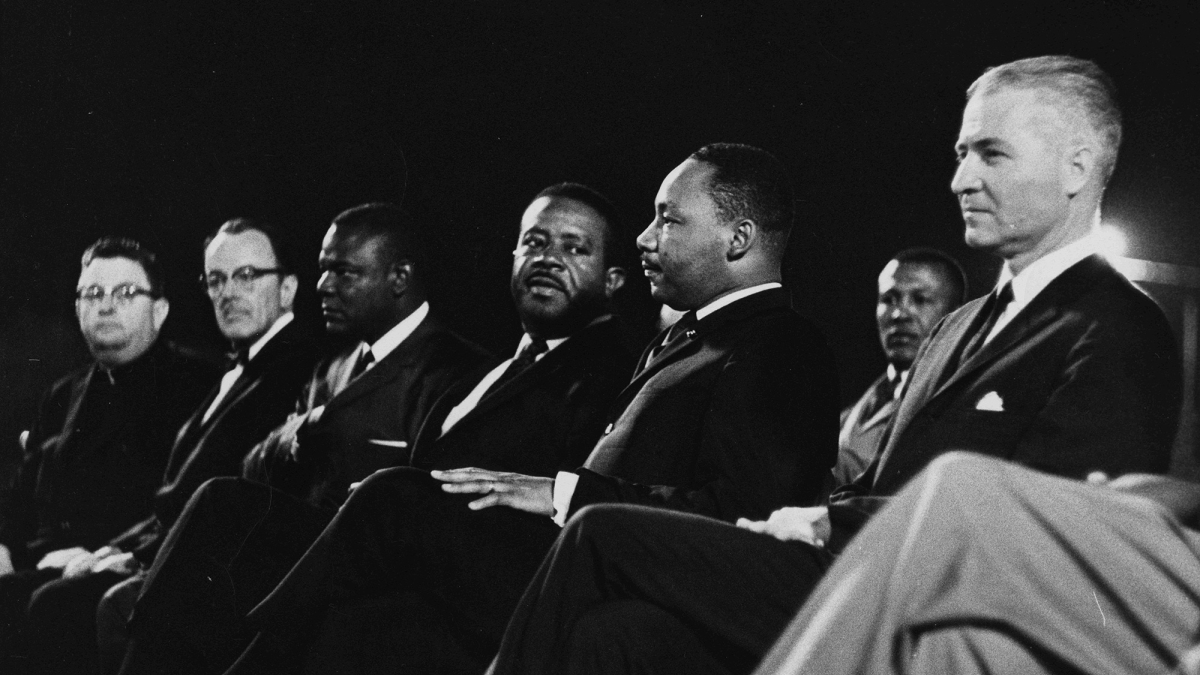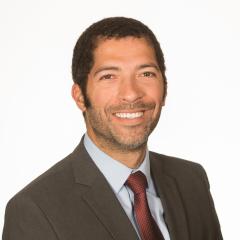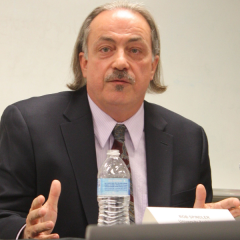ASU events show Martin Luther King Jr.'s contemporary relevance

Dr. Martin Luther King Jr. was a civil rights icon, a beacon of light during a dark time in American history, and a defender of the poor, downtrodden and underrepresented. But there was so much more to the man.
As the nation prepares for a national federal holiday on Monday marking King’s birthday, ASU will host a series of events on his life, legacy and examples of his servant leadership.
For this combined Q&A, ASU Now reached out to a trio of university experts who will participate in some of these events to help contextualize the life of King: Matthew Delmont, a history professor and director of the School of Historical, Philosophical and Religious Studies; Keith D. Miller, an English professor and interim director of the Center for the Study of Race and Democracy and Robert Spindler, university archivist at ASU Library.

Matthew Delmont
Question: What would most people be surprised to know about King or his writings?
Delmont: Most people know MLK's most famous speech, "I Have a Dream," but most people don't realize that the speech was over sixteen minutes long and includes some great lines like, “America has given the Negro people a bad check, a check which has come back marked, ‘insufficient funds.’”
Because "I Have a Dream" is so famous, I think most people would be surprised at how many places MLK spoke outside of the South. He lent support to civil rights activists in New York City, Chicago, Philadelphia, Boston, Los Angeles, and many other cities. The fact that he spoke at ASU in 1964 and that the speech went undiscovered for five decades is a good indication that we are are still learning new things about this iconic figure.
Finally, MLK is so iconic that it is easier to forget he did regular human things, like go on vacation to Jamaica with his wife in 1967.
Spindler: Many would be unaware that Dr. King spoke at Arizona State University on June 3, 1964. The event occurred on a hot summer evening at Goodwin stadium, which was the home of ASU football from 1936 until 1958.
About 8,000 individuals attended the event organized and promoted not by ASU but by the local NAACP chapter and Phoenix churches. Event organizers ran a small box advertisement in the Arizona Republic and post-event news coverage was minimal. Most ASU students had already left campus for summer vacation. Today his ASU speech, “Religious Witness for Human Dignity,” can be heard online here.
Miller: Martin Luther King Jr. was a political radical who hated what he termed the “triple evils” of poverty, racism and war. Unlike so many people, including many of his admirers, he did not consider racism to be an evil that could be combatted separately from poverty and violence. That’s because he viewed the triple evils as intertwined. He conducted his final campaign in Memphis on behalf of city garbage workers, who were all African-Americans. The campaign was equally a campaign against racism and a campaign on behalf of a labor union (AFSCME) whose laborers were on strike against the city because they were paid starvation wages.
The image of King as simply a champion of racial equality is false. His public image was sanitized in order to secure the passage of the King Holiday. It was sanitized again when a huge marble statue of him was erected in 2011 on the edge of the National Mall in Washington, D.C. Near the statue, quotations from King are inscribed in marble blocks. These quotations articulate his general comments about love and justice, and he definitely made those comments and many others like them. But the inscribed quotations divorce him from the centuries-old, African-American political struggle against slavery, lynching, disfranchisement, rape, segregation and discrimination.
He also hated the enormous Pentagon budget and explicitly supported Affirmative Action. Before he died, he told a staff member at his church that he wanted his next sermon to be titled “Why America May Go to Hell.” The national memory of King is, in many respects, way off the mark.

Keith D. Miller
Q: Which one of his works would be most indicative of who he was or what he thought?
Delmont: Like most people, I had never heard MLK's speech at ASU until the tape was rediscovered in 2014. The speech touches on many of the familiar themes in his work, and what stood out to me was his reference to the “myth of time.” He critiques those who say that with prayer and time racial injustice will work itself. He says, “Time is neutral, it can be used constructively or destructively” and goes on to say, “we may have to repent in this generation, not merely for the vitriolic words and the violent actions of the bad people who would bomb a church in Birmingham, Alabama, but for the appealing silence and indifference of the good people who sit around and say ‘wait on time.’”
He made a similar argument in the “Letter from Birmingham Jail” (1963) and in one of his last speeches, “Remaining Awake Through a Great Revolution” (March 31, 1968).
Spindler: The (ASU) recording is special because it occurred while the Civil Rights Act of 1964 was being filibustered in Congress and the state of Arizona still had separate and unequal public facilities laws on the books. At ASU, King called for an end to the delay on the federal legislation and also for passage or an Arizona public accommodations bill, and he called for an end to housing discrimination, noting that such discrimination also leads to unequal access to education, parks and other public services. If you skip to the end of the recording, you’ll hear King speak at the Tanner Chapel AME Church in downtown Phoenix earlier that day. This part of the recording is often overlooked. Here he greets attendees and especially a number of CORE workers. He said “… no section of this country can boast of clean hands in the area of brotherhood. We face the fact that racial injustice is a national problem. And I am convinced that one of the most urgent issues facing our nation at this time, is to work passionately and unrelentingly to solve this problem. And this problem is at bottom a moral problem.”
Miller: I think the tendency to valorize “I Have a Dream” also sanitizes him. That was not his most important oratory. His most crucial orations were part of a field of speeches, sermons, songs and prayers in Birmingham in April and May 1963.
As Pulitzer Prize-winning historian Diane McWhorter explains, Birmingham was the climax of the entire civil rights movement. Without Birmingham, hardly anyone would have shown up at the March on Washington in August 1963 to hear “I Have a Dream.” Birmingham was the site of city officials using police dogs and fire hoses against young African-American children engaged in nonviolence and civil disobedience while being arrested and jailed. Capped by speeches given by numerous orators, rallies in Birmingham spurred demonstrators and turned the tide of public opinion. Charles Billups’ miracle march caused the firefighters to inexplicably drop their hoses — a great victory for nonviolence. Birmingham also prompted President Kennedy to finally propose a major civil rights act. As King’s close friend and big fundraiser Harry Belafonte explains, without a triumph in Birmingham, King (who was defeated in his previous campaign in Albany, Georgia) might have been finished as a civil rights leader.
The most amazing feature of Birmingham occurred before King arrived. Between 1956 and 1963, local churches held civil rights rallies every Monday night, even though between 1956 and 1961, the national news media reported absolutely nothing about Birmingham, despite many (Ku Klux) Klan bombings of African-Americans' homes and churches. Somehow several hundred working-class people kept the faith that, despite the utter viciousness of their Klan-run city, they could, in some way or other, overthrow segregation. Birmingham is absolutely as important as the Battle of Gettysburg or any other turning point in American history since 1789.
I wrote an entire book about King’s final speech, “I’ve Been to the Mountaintop,” which is arguably his greatest address. In it, he argues that America still faces a tremendous racial crisis, and he aligns the ongoing strike in Memphis alongside the Exodus, the Protestant Reformation, and the Emancipation Proclamation. The fiftieth anniversary of the speech will occur in April 2018, and it will be interesting to see whether the national news media will notice the anniversary or will dishonor King by reducing him to a single speech — “I Have a Dream” — as though he died in 1963 instead of 1968.

Robert Spindler
Q: If MLK were still alive, how do you think he would address the racial challenges in America today?
Delmont: At the end of his life, MLK was organizing the Poor People’s Campaign and speaking against the war in Vietnam. It is important to remember that the majority of white Americans were not really on board with the goals of the civil rights movement or with MLK's views, especially not in the late 1960s.
If MLK were still alive, I do not expect that he would be widely revered by most Americans. Still, I think he would be in support of Rev. Dr. William J. Barber II, and his work to restart the Poor People's Campaign and a Moral Movement. I also expect he would support the Black Lives Matter activists, though there would likely tensions in terms of age and gender, as there were during the 1950s and 1960s.
Finally, I think he would be deeply saddened that many of the same battles he fought against racism are still going on today, but he would still keep on fighting.
Spindler: I think he would be alarmed by the continuing violence directed at black men and women and the disproportionate incarceration of black men in America. King would have supported the Black Lives Matter movement. I believe he would have continued to call for non-violent but active resistance that precipitates rapid action and changes in public policy.
I also think he would call us out as individuals by asking what we can do to teach our children how to work within the system for constructive change toward a more compassionate and equal American society.
Miller: I would like to pose the question differently. Many of the protestors who generated the civil rights movement of the 1950s and 1960s are still alive. Many of them are still activists campaigning in various ways — through their books, photography, music, art, midwifery, UN diplomacy, and marches — against racial inequity and other social inequities.
Unlike textbook writers, who define the civil rights era as occurring from Rosa Parks in 1955 until King’s assassination in 1968, they assume that the movement did not end with King’s death. They think it is still going on, albeit with less attention from the national news media. Although no one can exactly summarize their various perspectives, it is safe to say that they generally believe that the civil rights movement has a lot more work to do because, obviously, white supremacist notions have far from disappeared.
MLK Day events featuring our experts:
Matthew Delmont
The Legacy of Martin Luther King Jr. as American Leader and Statesman
4–5 p.m. Jan. 17, Hayden Library, Tempe campus
The inaugural presentation of two signed books by Martin Luther King Jr., both added to the ASU archive in the first week of 2018. Autographed, first edition copies of “Strength to Love,” the 1963 collection of King's sermons, and “Stride Toward Freedom,” King's 1958 memoir of the Montgomery Bus Boycott, will be on view in Tempe’s Hayden Library from 4 to 5 pm on Jan. 17. At 4 p.m., Delmont will discuss the endurance of King's work, his legacy in Arizona, and his 1964 speech at ASU, less than a month before the signing of the Civil Rights Act.
Keith Miller
Miller will appear on AZ Horizon (AZ PBS) Monday as part of its MLK Day coverage. Miller, who is an expert on King’s rhetoric and the author of two books, including “Martin Luther King’s Biblical Epic: His Final Great Speech,” will discuss King’s life, work and writings.
Top photo: G. Homer Durham, Martin Luther King, Jr., Ralph Abernathy, an unidentified participant, Rev. Louis Eaton and Monsignor Robert Donahoe at Goodwin Stadium, Arizona State University. June 3, 1964. Photo courtesy of ASU Library.